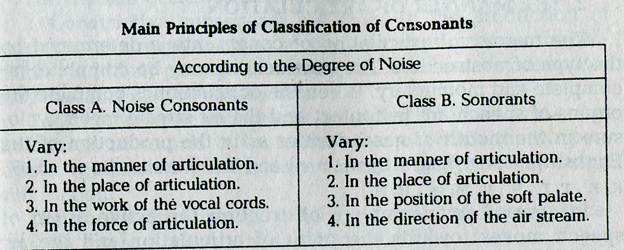PRINCIPLES OF CLASSIFICATION
VOWELS AND CONSONANTS
The organs of speech are capable of uttering many different kinds of sounds. From the practical point of view it is convenient to distinguish two types of speech sounds: vowels and consonants. Vowels are voiced sounds produced without any obstruction in the supra-glottal cavities and consequently have no noise component. In the articulation of consonants a kind of noise producing obstruction is formed in the supra-glottal cavities. Such sounds may be pronounced with or without vocal vibration.

PRINCIPLES OF CLASSIFICATION
Consonants are made with air stream that meets an obstruction in the mouth or nasal cavities. That is why in the production of consonant sounds there is a certain degree of noise.
Consonants are the bones of a word and give it its basic shape. English accents differ mainly in vowels, the consonants are more or less the same wherever English is spoken. So if your vowels are not perfect you may still be understood by the listener, but if the consonants are imperfect there may be some misunderstanding.
The sentence "W-l y- -nv-t- m-1- th- p-t-?" "Will you invite me to the party?" is easy for understanding even if all the vowel letters would be left out. But if we leave all the consonant letters out ; "-i- -ou i--i-e -e -o —e -a--y" it is impossible to make any sense out of it. Thus we see that there are good reasons for beginning the course of pronunciation with consonants. On the articulatory level the consonants change:
1. In the degree of noise.
2. In the manner of articulation.
3. In the place of articulation.
According to the degree of noise English and Russian consonants are divided into two big classes:
Class A. Noise consonants.
Class B. Sonorants.
A. In the production of noise consonants there is a noise component characteristic. Noise consonant sounds vary:
(11 In the work of the vocal cords,
(2) in the degree of force of articulation.
According to the work of the vocal cords they may be voiceless and voiced.
When the vocal cords are brought together and vibrate we
hear voice.
Voiced consonants are: the English [b, d, g, v, d, z, 3, cfe]; in Russian [ 6, 6',B, b', r, r', a- A', *, 3, s'].
If the vocal cords are apart and do not vibrate we hear only noise and the consonants are voiceless.

Voiceless consonants are: the English [p, t, k, f, 6, s, J, tf, h]; the Russian [n, n', dp, (p', k, k', t, t', in, in', h', u., x, x'].
Voiced consonants are not fully voiced in all word positions, in word final position, for example, they are partly devoiced.
The degree of noise may vary because of the force of articulation. Strong noise consonants are produced with more muscular energy and stronger breath effort. Weak noise consonants are produced with a relatively weak breath effort.
Strong noise consonants are: the English [p, t, k, f, 0, s, J, h, tf].